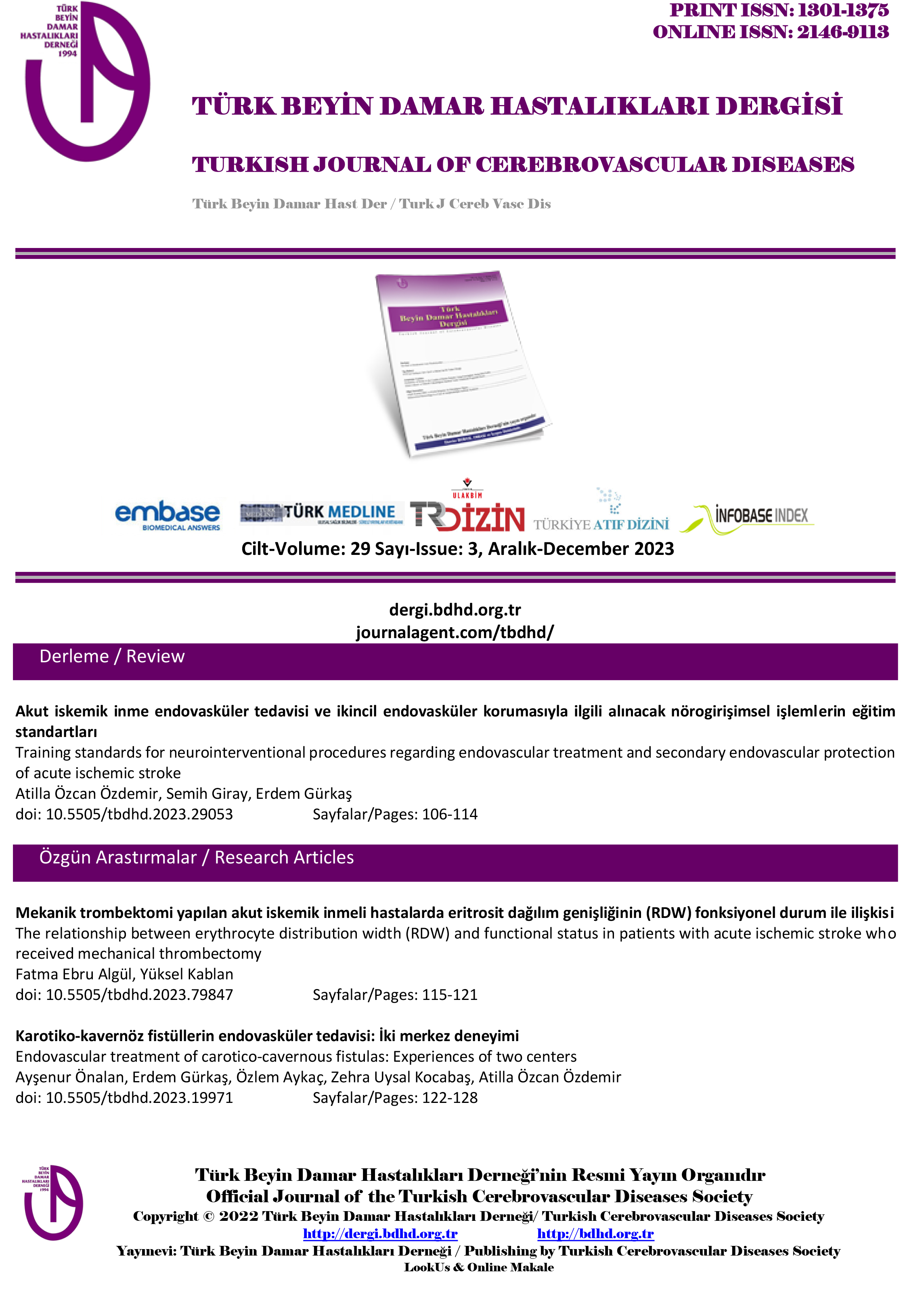Detection of microembolic signals before and after stent treatment of patients with carotid stenosis and determination of related factors
Pınar Uzun Uslu1, Mustafa Bakar2, Bahattin Hakyemez31Eskişehir City Hospital Neurology Clinic, Eskişehir, Turkey2Uludag University Faculty of Medicine, Department of Neurology, Bursa, Turkey
3Uludag University Faculty of Medicine, Department of Radiology, Bursa, Turkey
INTRODUCTION: Ischemic stroke is among the primary causes of morbidity and mortality in the world. Carotid artery stenosis plays a critical role in the etiology of ischemic stroke. Carotid artery stenting (CAS) in severe carotid artery stenosis is an alternative treatment to endarterectomy in both symptomatic and asymptomatic patients and it is increasingly preferred. Microembolic signals (MES), which can be detected by transcranial doppler (TCD), can arise due to either carotid artery stenosis or CAS. In our study, MES count was performed before and after stent treatment to determine its associated condition.
METHODS: This prospective our study includes a total of 40 symptomatic and asymptomatic patients scheduled for carotid artery stenting. Demographic properties, anamnesia, risk factors, medical treatments, vital parameters and neuroimaging results of the patients were evaluated. National Institutes of Health Stroke Scale (NIHSS) and modified Rankin Scale (mRS) scores before and after CAS were calculated. MES counts were performed with TCD and DWI 12-24 hours before and 12-24 hours after CAS. Clinical findings and complications were monitored after the stent.
RESULTS: While 44,7% of the patients were ipsilateral MES before the stent, 13,2% were ipsilateral MES after the stent. 55% of the patients had new silent infarct after the stent. Before and after CAS, patients NIHSS was 1,7 and mRS was 0,6. No significant correlation was detected between MES and DWI results. However, plaque morphology was found to have an effect on result of both MES and DWI (p<0.05)
DISCUSSION AND CONCLUSION: Microembolic signals are considered as a parameter that can lead to stroke recurrence and neuronal ischemic damage. Therefore, imaging cerebral microembolies is becoming increasingly important. Recent studies and developed methods significantly decreased the risk of CAS-related major complications and stroke. Nevertheless, in order to decrease the microembolic signals that arise in the meantime with no clinical symptoms, more comprehensive studies are required.
Karotis stenozu olan hastaların stent tedavisi öncesi ve sonrasında mikroembolik sinyallerinin tespit edilerek ilişkili olduğu faktörlerin belirlenmesi
Pınar Uzun Uslu1, Mustafa Bakar2, Bahattin Hakyemez31Eskişehir Şehir Hastanesi, Nöroloji Kliniği, Eskişehir2Uludağ Üniversitesi Tıp Fakültesi, Nöroloji Anabilim Dalı, Bursa
3Uludağ Üniversitesi Tıp Fakültesi, Radyoloji Anabilim Dalı, Bursa
GİRİŞ ve AMAÇ: İskemik inme, dünyada mortalite ve morbiditenin önde gelen nedenlerindendir. İskemik inme etyolojisinde karotis arter stenozu önemli bir rol oynamaktadır. Ciddi karotis darlıklarında karotis arter stentleme (CAS), hem semptomatik hem de asemptomatik hastalarda endarterektomiye alternatif bir tedavidir ve CASın tercih edilme sıklığı giderek artmaktadır. Transkraniyal doppler (TCD) ve difüzyon MR (DWI) saptanabilen mikroembolik sinyallerler (MES) hem karotis arter stenozuna bağlı hem de CASa bağlı olarak ortaya çıkabilir. Çalışmamızda hastalarda stent tedavisi öncesi ve sonrası MES sayımı yapılarak ilişkili olduğu durumlar saptanmak istenmiştir.
YÖNTEM ve GEREÇLER: Prospektif olarak yaptığımız bu çalışmaya karotis arter stentleme kararı verilmiş olan semptomatik ve asemptomatik 40 hasta dahil edildi. Hastaların demografik özellikleri, anamnezleri, risk faktörleri, medikal tedavileri, vital parametreleri ve nörogörüntülemeleri değerlendirildi. CAS öncesi ve sonrası National Institutes of Health Stroke Scale (NIHSS) ve modified Rankin Scale (mRS) hesaplandı. Hastalara CASdan 12-24 saat önce ve 12-24 saat sonra TCD ve DWI ile MES sayımı yapıldı. Stent sonrası klinik bulgular ve komplikasyonlar takip edildi.
BULGULAR: Hastaların %44,7sinde stent öncesi, %13,2sinde stent sonrası ipsilateral MES saptandı. %55 hastada stent sonrası yeni sessiz enfarkt olduğu görüldü. CAS öncesi ve sonrası hastaların NIHSS: 1,7 ve mRS: 0,6 olarak saptandı. MES ve DWI sonuçları arasında anlamlı bir ilişki saptanmadı. Ancak plak morfolojisinin hem MES hem de DWI sonuçlarına anlamlı etkisi olduğu tespit edildi (p<0,05).
TARTIŞMA ve SONUÇ: Mikroembolik sinyaller inme rekkurrensine ve nöronal iskemik hasara yol açabilecek bir parametre olarak kabul edilmektedir. Bu nedenle serebral mikroembolileri de gösterebilmek giderek önemli hale gelmektedir. Günümüzde yapılan çalışmalar ve geliştirilen yöntemler ile CAS‗a bağlı majör komplikasyon ve inme riski oldukça azalmıştır. Ancak bu süreçte klinik bulgu vermeden ortaya çıkan mikroembolik sinyalleri de azaltabilmek için daha kapsamlı çalışmalara ihtiyaç olduğu düşünülmektedir.
Corresponding Author: Pınar Uzun Uslu, Türkiye
Manuscript Language: English










